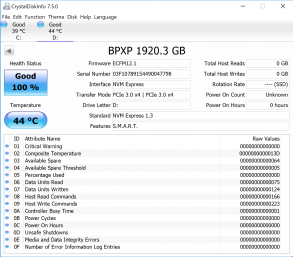

So this seems like a better option than using a SATA SSD (I could be wrong here but worth experimenting with - See this PCWorld Article for more detail). Glotrends PCIE NVMe Adapter Card PCIE GEN3 Full Speed for PC Desktop The motherboard didn’t support x3 lanes, but even so with x2 lanes he was getting an impressive 1600 MB/s If you’ve an old desktop, even a 14 year old motherboard (as my good friend has done) you can put in an M.2 NVMe drive using a PCI Express adapter. Notice it is 5 times the speed of the best HDD’s I have! PCI Express to M.2 NVMe This is interesting - the perf of a relatively new HDD hasn’t improved a lot. HDD - 8 years oldĬame with my XPS17 laptop (had dual ones of this drive) HDD - 5 years oldĤTB Western Digital inside a fast desktop. Good article on Amazon about disks HDD - 10 years oldįrom around the 2010 era of an Apple MacBook Pro.
 M.2 - wafer thin using a speed up technique called NVMe. SATA Usually 2.5 inch same size as Laptop HDD. Laptops use 2.5” and full size are 3.5”. Reviewers on Amazon commonly use this tool HDD / SSD / M.2 NVMe This got me curious as to performance differences between modern day drives and older drives.ĬrystalDiskInfo is good for the information, and CrystalDiskMark - scroll down page gives a good idea of benchmark speed. It took all day to install Windows 10 and updates (compared to an hour or so I’d expect) Then you need to do nothing, the main interface will list all the info of the disk and tell you if the disk status is “Good”.I needed to reinstall Win10 on my spare laptop that I’d stolen the SSD out of and had a 10 year old hard disk sitting around. Get-PhysicalDisk –FriendlyName PhysicalDisk1 | Get-StorageReliabilit圜ounterĬrystalDiskInfo is the free open source portable program that can check disk S.M.A.R.T info with much more details returned.ĭownload the zip file and run the 32-bit.exe or the 64-bit.exe directly without installation. Get-Disk 0 | Get-StorageReliabilit圜ounter Get-WmiObject -Class win32_diskdrive -Property STATUSĭisk’s status will be displayed at the end of the line. If you’re using PowerShell in Windows 10, you can use the following command instead to check S.M.A.R.T info. WMIC: Windows Management Instrumentation Command-line. There’s no need to worry about the disk if it say “OK”, but do pay attention to other messages, which indicate the disk has error in S.M.A.R.T info. Then it will start to analyze and display the result as “OK”, “Bad”, “Caution” or “Unknown”. type the command wmic and then type diskdrive get status and press enter. Press Windows+R to open the Run dialog box and type cmd and press enter to open it. CMD check S.M.A.R.T infoįirst, let’s try the default method, CMD, or Command Prompt in Windows 10. The Windows default methods will only display simple messages about the hard drive, but CrystalDiskInfo, the freeware and portable program will list almost every details of disks, no matter it’s HDD, HHD, or SSD.
M.2 - wafer thin using a speed up technique called NVMe. SATA Usually 2.5 inch same size as Laptop HDD. Laptops use 2.5” and full size are 3.5”. Reviewers on Amazon commonly use this tool HDD / SSD / M.2 NVMe This got me curious as to performance differences between modern day drives and older drives.ĬrystalDiskInfo is good for the information, and CrystalDiskMark - scroll down page gives a good idea of benchmark speed. It took all day to install Windows 10 and updates (compared to an hour or so I’d expect) Then you need to do nothing, the main interface will list all the info of the disk and tell you if the disk status is “Good”.I needed to reinstall Win10 on my spare laptop that I’d stolen the SSD out of and had a 10 year old hard disk sitting around. Get-PhysicalDisk –FriendlyName PhysicalDisk1 | Get-StorageReliabilit圜ounterĬrystalDiskInfo is the free open source portable program that can check disk S.M.A.R.T info with much more details returned.ĭownload the zip file and run the 32-bit.exe or the 64-bit.exe directly without installation. Get-Disk 0 | Get-StorageReliabilit圜ounter Get-WmiObject -Class win32_diskdrive -Property STATUSĭisk’s status will be displayed at the end of the line. If you’re using PowerShell in Windows 10, you can use the following command instead to check S.M.A.R.T info. WMIC: Windows Management Instrumentation Command-line. There’s no need to worry about the disk if it say “OK”, but do pay attention to other messages, which indicate the disk has error in S.M.A.R.T info. Then it will start to analyze and display the result as “OK”, “Bad”, “Caution” or “Unknown”. type the command wmic and then type diskdrive get status and press enter. Press Windows+R to open the Run dialog box and type cmd and press enter to open it. CMD check S.M.A.R.T infoįirst, let’s try the default method, CMD, or Command Prompt in Windows 10. The Windows default methods will only display simple messages about the hard drive, but CrystalDiskInfo, the freeware and portable program will list almost every details of disks, no matter it’s HDD, HHD, or SSD.






 0 kommentar(er)
0 kommentar(er)
